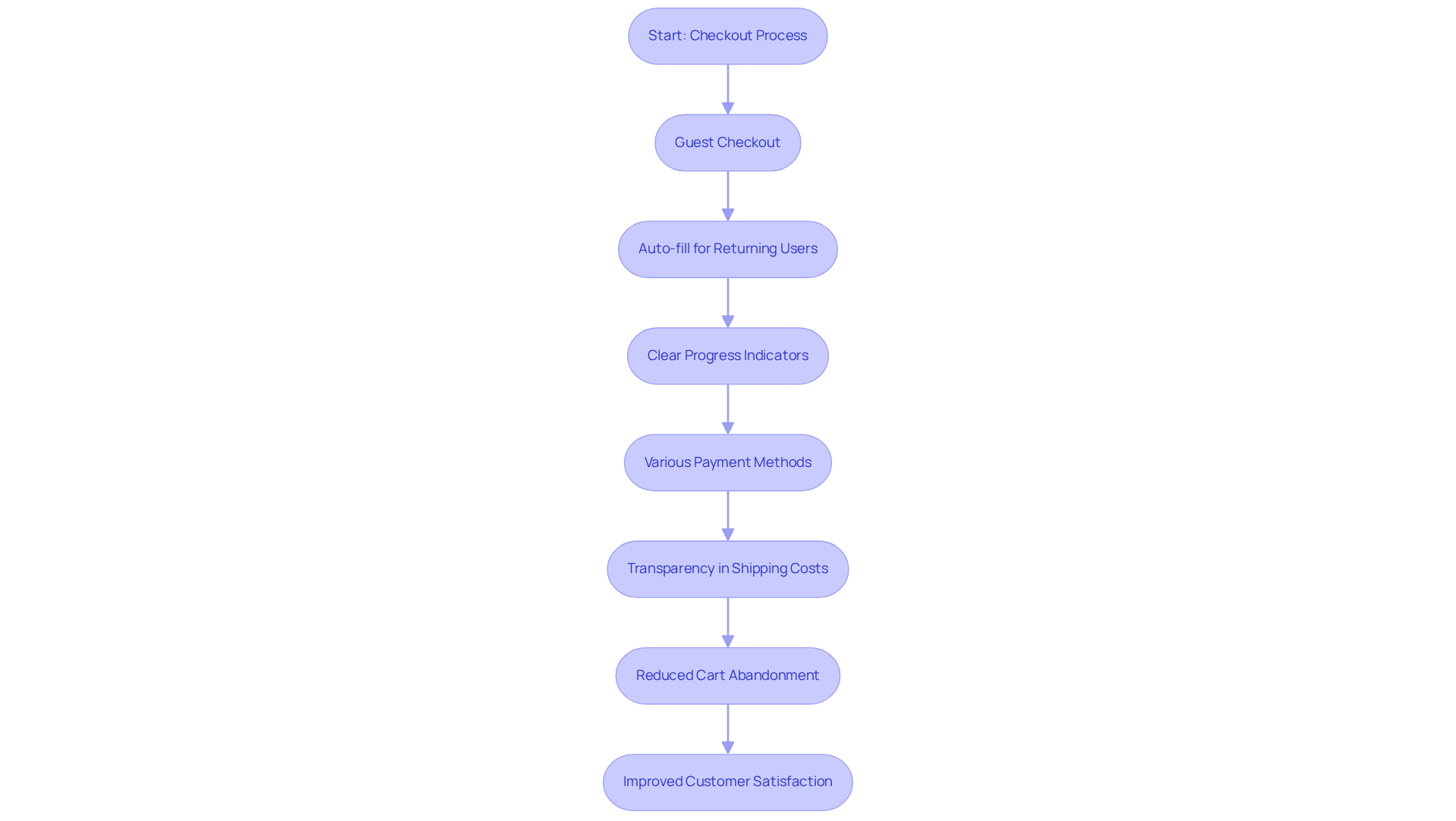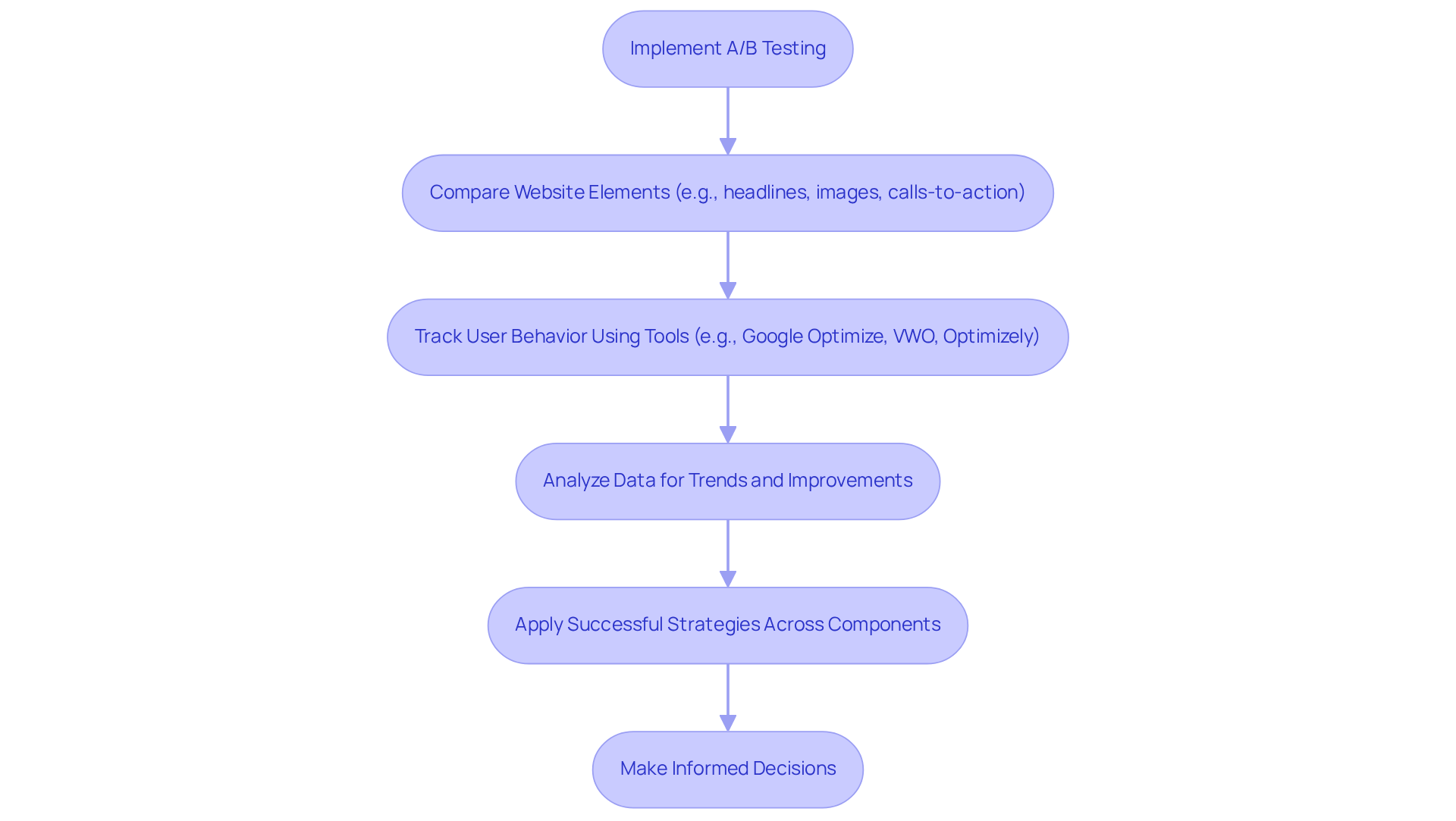
Overview
Effective eCommerce design hinges on four pivotal practices:
- Establishing user-centric design principles
- Implementing visual and functional enhancements
- Streamlining the checkout experience
- Utilizing A/B testing alongside data-driven insights
These practices are not merely suggestions; they are foundational elements that collectively enhance user engagement, increase conversion rates, and significantly improve overall customer satisfaction. By prioritizing user needs, ensuring aesthetic appeal, optimizing purchasing processes, and committing to continuous improvement based on empirical data, businesses can create a compelling online shopping experience that resonates with consumers. Embrace these strategies to transform your eCommerce platform into a powerful tool for success.
Introduction
Creating an effective eCommerce website is no small feat; it demands a meticulous blend of user-centric design, compelling visuals, and a seamless checkout experience. As online shopping increasingly dominates consumer behavior, understanding and implementing key practices can significantly enhance user engagement and elevate conversion rates. Yet, with a multitude of elements to consider, how can businesses ensure their site distinguishes itself in a crowded digital marketplace? This article delves into four essential practices for eCommerce design that not only attract visitors but also convert them into loyal customers.
Establish User-Centric Design Principles
To establish , begin with thorough research to grasp your target group's preferences, pain points, and behaviors. Employ tools such as customer surveys and session recordings to collect valuable insights. Structure your website and navigation based on these findings, ensuring that they are intuitive and meet visitor expectations. A well-organized menu and clear calls-to-action significantly enhance the visitor experience. Additionally, prioritize accessibility standards to ensure that everyone, including individuals with disabilities, can navigate your site effectively. By centering your site ecommerce design around customer needs, you create a more engaging shopping experience that can lead to increased sales.

Implement Visual and Functional Enhancements
Visual appeal is paramount in site ecommerce design, significantly influencing . High-quality images and captivating videos, along with consistent branding elements, create a visually cohesive experience that enhances site ecommerce design and attracts individuals. Given that over 50% of online purchases are made on mobile devices, responsive design is essential for optimal performance across all devices. Functional enhancements such as product zoom, 360-degree views, and customer reviews enrich the site ecommerce design, fostering trust and encouraging purchases.
These improvements in site ecommerce design can lead to significant boosts in customer engagement, as attractive visuals and smooth functionality guide users through their shopping journey. Notably, humans process visual information 60,000 times faster than text, which underscores the critical role of visuals in site ecommerce design. A case study demonstrated that an online shoe store enhanced its conversion percentage from 2% to over 4% after revamping its homepage and checkout process, showcasing the significant role of site ecommerce design on sales performance.

Streamline the Checkout Experience
To enhance the checkout experience, it is essential to minimize the steps required for individuals to finalize their purchases. Implementing guest checkout options can significantly lower cart abandonment rates, as many shoppers prefer not to create an account before making a purchase. Research indicates that approximately 75% of shoppers who abandon their carts intend to return to complete their purchase, and 63% of abandoned merchandise is potentially recoverable by online retailers. This highlights the potential for recovery through a simplified process.
In addition to guest checkout, features such as auto-fill for returning users and clear progress indicators can guide individuals smoothly through the checkout process. Offering various payment methods, including popular options like digital wallets and Buy Now Pay Later (BNPL), caters to different preferences and increases the likelihood of successful transactions. Transparency is crucial; clearly communicating shipping costs and delivery times before the final purchase step effectively manages buyer expectations. Notably, 50% of consumers consider the ease of a merchant's checkout process when deciding where to shop, underscoring the importance of a streamlined experience.
By streamlining the checkout process and addressing common issues, eCommerce brands can significantly enhance consumer satisfaction and improve their site ecommerce design to drive higher conversion rates. This approach not only reduces cart abandonment but also fosters long-term loyalty among clients, ultimately leading to increased profitability. Furthermore, a well-structured return policy can bolster customer confidence, further supporting successful transactions. With the potential for a through improved site ecommerce design, the advantages of these strategies are clear.

Utilize A/B Testing and Data-Driven Insights
Implement A/B testing to compare different versions of your website elements—headlines, images, and calls-to-action. This powerful approach allows you to identify which variations yield the most favorable outcomes in audience engagement and conversion metrics. Utilize such as Google Optimize, VWO, or Optimizely to meticulously track user behavior and gather insights on how visitors interact with your site. Regular analysis of this data reveals trends and areas ripe for improvement.
For example, if a specific call-to-action button color leads to increased click-throughs, consider applying similar strategies across other components. A/B testing has consistently demonstrated significant improvements in performance metrics; companies report enhancements such as a 36% increase in ROI on advertisements from Parah Group clients. Additionally, case studies like bimago's A/B testing success, which resulted in a remarkable 44% increase in conversions, underscore the potential impact of this approach.
However, remain vigilant against common pitfalls, such as testing too many variables simultaneously or prematurely halting tests. By leveraging data-driven insights, you can make informed decisions that enhance your site ecommerce design's effectiveness and improve the user experience.

Conclusion
Creating an effective eCommerce site is not just an option; it is a necessity for brands aiming to thrive in a competitive landscape. A strategic approach centered on user experience, visual appeal, and data-driven decision-making is paramount. By prioritizing user-centric design principles, brands can significantly enhance their website's functionality and engagement. This, in turn, leads to higher conversion rates and increased customer satisfaction. The importance of understanding the target audience cannot be overstated; insights gleaned from research directly influence site navigation and overall design.
Key practices such as:
- Implementing visual and functional enhancements
- Streamlining the checkout process
- Utilizing A/B testing
are vital components of successful eCommerce design. High-quality visuals and a seamless user experience not only attract potential customers but also facilitate smoother transactions. Simplifying the checkout process can drastically reduce cart abandonment rates, while data-driven insights empower brands to make informed adjustments that optimize their site’s performance.
Ultimately, the significance of these practices extends beyond mere aesthetics; they form the foundation for a thriving eCommerce business. By committing to continuous improvement and adapting to consumer preferences, brands can create an engaging online shopping environment that fosters loyalty and drives profitability. Embracing these strategies today will undoubtedly pave the way for sustained success in the ever-evolving eCommerce landscape.
Frequently Asked Questions
What is the first step in establishing user-centric design principles?
The first step is to conduct thorough research to understand your target group's preferences, pain points, and behaviors.
What tools can be used to gather insights about the audience?
Tools such as customer surveys and session recordings can be employed to collect valuable insights about the audience.
How should a website be structured based on audience research?
The website and navigation should be structured based on the research findings, ensuring they are intuitive and meet visitor expectations.
Why is a well-organized menu important for a website?
A well-organized menu and clear calls-to-action significantly enhance the visitor experience by making navigation easier.
What should be prioritized to ensure accessibility on a website?
Accessibility standards should be prioritized to ensure that everyone, including individuals with disabilities, can navigate the site effectively.
How does centering ecommerce design around customer needs benefit a business?
By centering ecommerce design around customer needs, it creates a more engaging shopping experience that can lead to increased sales.
FAQs











